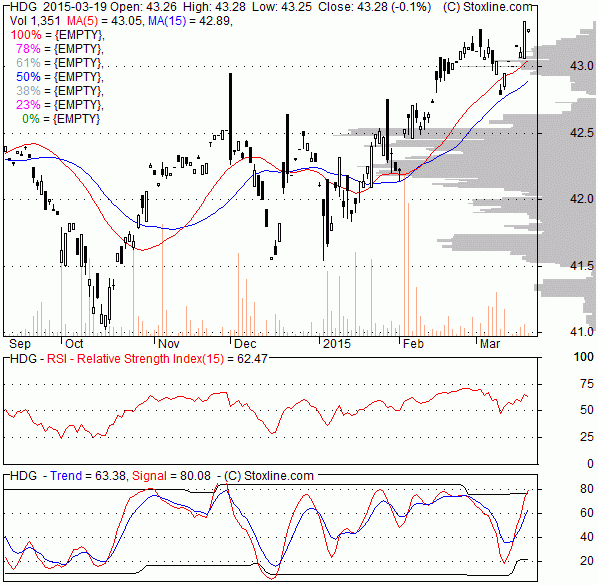ProShares Hedge Replication ETF (HDG)
Post on: 16 Март, 2015 No Comment

Hedge Fund Exposure in a Flexible ETF Format
Fund: Hedge Replication ETF
Intraday Ticker: HDG.IV
Investment Objective: Seeks investment results (before fees and expenses) that track the performance of the Merrill Lynch Factor Model – Exchange Series (MLFM-ES).
Gross Expense Ratio: 1.68%
Expense Ratio: 0.95% 1
Bloomberg Index Symbol: MLEIFCTX
By tracking a hedge fund replication benchmark, ProShares Hedge Replication ETF (HDG) seeks to generate the risk and return characteristics of a broad universe of hedge funds while avoiding or overcoming many of the challenges of investing in a hedge fund.
Before we talk about the advantages of HDG, let’s first review hedge fund investing and hedge replication:
The Role of Hedge Fund Investing
Over the past decade, investors have become more conscious of the inherent risks of investing only in traditional asset classes like stocks and bonds. Many are seeking a better balance of risk and return through alternative investments like hedge funds.
- Hedge funds have become increasingly popular with investors because they historically have had attractive risk-adjusted returns relative to stocks and bonds (see chart below)
- As a group, hedge funds have also done a good job of managing downside risk
Hedge Fund Allocation Improved Historical Risk
The Challenges of Hedge Funds
For a variety of reasons, hedge funds have been out of reach for many investors.
- Hedge funds often restrict access
- They may have higher investment minimums
- Funds may be closed to new investment
Now, an approach known as hedge fund replication may provide an alternative to investing directly in a hedge fund.
What Is Hedge Fund Replication?
Hedge fund replication is a quantitative strategy that attempts to recreate the risk and return profile of a broad universe of hedge funds. One approach is known as factor replication, which attempts to determine combinations and weightings of financial market factors—such as the returns of indexes—that historically have had a high correlation with hedge fund performance. Academic research has shown that a substantial portion of hedge fund returns is derived from exposure to market factors.
Hedge Fund Research, Inc. Fund Weighted Composite Index
Replication starts with an index of hedge fund performance. This index, from a global leader in the alternative investments industry, represents more than 2,200 hedge funds.
Merrill Lynch Factor Model – Exchange Series
Next, this benchmark seeks to provide the risk and return characteristics of the hedge fund asset class by targeting a high correlation to the HFRI. Established by Merrill Lynch, a pioneer in hedge fund replication, the MLFM-ES seeks to replicate the portion of hedge fund returns that is attributable to market exposure.
ProShares Hedge Replication ETF (HDG)
The fund seeks exposure to the six market factors underlying the benchmark, MLFM-ES, investing in equities, ADRs, derivatives such as swaps, forwards and futures, and U.S. Treasury bills. The fund does not invest directly in hedge funds.
How Hedge Fund Replication Works
Source: Merrill Lynch
ProShares Hedge Replication ETF: The Advantages
ProShares Hedge Replication ETF (HDG) unlocks many of the advantages of hedge funds, and also offers:
Accessibility
You can trade ProShares Hedge Replication ETF in your brokerage account, and shares can be bought and sold at any time during trading hours.
Transparency
Holdings are reported daily at ProShares.com. The fund obtains its exposure through readily available, liquid and marketable securities or derivatives.
Manager diversification
The fund’s benchmark, Merrill Lynch Factor Model – Exchange Series, aims to replicate an index of more than 2,200 hedge funds, representing multiple investment strategies.
Regulatory oversight
The fund is regulated as an investment company, like most exchange traded funds, and has the same reporting requirements.
Convenient tax reporting
ProShares Hedge Replication ETF reports capital gains and dividends on Form 1099.
Potential Risks
MLFM-ES is structured to replicate the return of a broad universe of hedge funds, not the returns of top-performing funds. HDG does not invest directly in hedge funds or in funds-of-hedge-funds. Individual hedge funds or funds-of-hedge-funds may generate materially higher or lower returns than HDG, its benchmark index or the average return of a broad universe of hedge funds. Derivatives used to seek long and short exposure may increase volatility and decrease performance under certain market conditions. For more on risks, see the prospectus .














